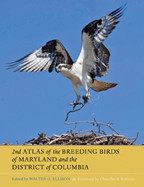
Reviews
A meticulously detailed guide, with lush color photos.
This magnificently illustrated book brings together the efforts of hundreds of citizen scientists to reveal which species of reptiles and amphibians live in Maryland and where in the state they live. It is truly a quantum leap in our understanding of this magnificent wildlife and provides an invaluable baseline to plan for the protection of Maryland’s unique fauna.
Authoritatively presented and beautifully illustrated, this atlas is a comprehensive manual that explores the natural history of Maryland's amphibians and reptiles and the efforts by public agencies and individual naturalists to conserve this priceless legacy. Cunningham, Nazdrowicz, and all their contributors also offer readers a history of the naturalists who wandered the breadth of the state documenting these invaluable animals.
This is one of the best state herpetological atlases I have read. Each species has good natural history coverage, photographs, and distributional maps. Several good appendices and a thorough reference section are included. I highly recommend this book for those interested in mid-Atlantic herps.
The Maryland Amphibian and Reptile Atlas is a superb blend of scientific monograph and field guide and an example of the database most needed for future ecosystem analyses and conservation practice.
This is the definitive field guide to the amphibians and reptiles of Maryland. This beautiful, easy-to-use book provides color photos, range maps, and natural history information for each species. A fantastic resource for amateurs and experts of all ages!
This gorgeously illustrated tome is deeply compelling especially because of the inclusion of field observations and outstanding photography of nonprofessional herpetologists. This fine volume is a joy to read, due in part—as was the case with each of my several books on herpetology—to these contributions from gifted citizen scientists.
Book Details
Acknowledgments
Acronyms and Abbreviations
Part I. Introduction
Overview of Amphibians and Reptiles in Maryland
The Maryland Amphibian and Reptile Atlas Project
Citizen Science and Herpetological
Acknowledgments
Acronyms and Abbreviations
Part I. Introduction
Overview of Amphibians and Reptiles in Maryland
The Maryland Amphibian and Reptile Atlas Project
Citizen Science and Herpetological Research
Goals of the Atlas
Organization of the Atlas
Part II. History of Herpetofaunal Distributions in Maryland. Charles A. Davis
Discovery
Collections and Descriptions
Organizing for Discovery and the Early Amphibian and Reptile Collections
Limitations and Challenges of Assessing Historical Ranges: Where Were the Rattlesnakes?
Early Geographic Lists
More Efforts to Organize
Efforts to Update the Distributional Survey
Challenges and Practices for Gathering Distributional Data
Additional Institutional Efforts That Document Amphibian and Reptile Distributions
Rare Species Surveys
Increasing Access to Herpetofaunal Information
Part III. Maryland's Environment
Physiographic Provinces
Habitat Types
Climate
Land Use
Part VI. Conservation of Maryland's Herpetofauna. Lynn M. Davidson and Glenn D. Therres
Legislation, Regulation, and Monitoring Programs
Protected Lands
Part V. Designing and Implementing the Atlas Project
Coordination
Survey Methodology
The Volunteer Network
Data Collection
Data Management
Part VI. Results of the Atlas Project
Overall Results
County-Level Results
Volunteer Results
Data Verification
Taxonomic Results
Part VII. Species Accounts
Amphibians
Reptiles
Appendixes
A. Quadrangle and Block Total Species Summary
B. Quadrangle and Block Effort-Hours Summary
C. County Summary
D. Species Summary
References
Index





